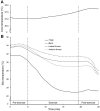Effect of cold ambient temperature on heat flux, skin temperature, and thermal sensation at different body parts in elite biathletes
- PMID: 36406769
- PMCID: PMC9666787
- DOI: 10.3389/fspor.2022.966203
Effect of cold ambient temperature on heat flux, skin temperature, and thermal sensation at different body parts in elite biathletes
Abstract
Introduction: When exercising in the cold, optimizing thermoregulation is essential to maintain performance. However, no study has investigated thermal parameters with wearable-based measurements in a field setting among elite Nordic skiers. Therefore, this study aimed to assess the thermal response and sensation measured at different body parts during exercise in a cold environment in biathletes.
Methods: Thirteen Swiss national team biathletes (6 females, 7 males) performed two skiing bouts in the skating technique on two consecutive days (ambient temperature: -3.74 ± 2.32 °C) at 78 ± 4% of maximal heart rate. Heat flux (HF), core (Tcore) and skin (Tskin) temperature were measured with sensors placed on the thigh, back, anterior and lateral thorax. Thermal sensation (TS) was assessed three times for different body parts: in protective winter clothing, in a race suit before (PRE) and after exercise (POST).
Results: HF demonstrated differences (p < 0.001) between sensor locations, with the thigh showing the highest heat loss (344 ± 37 kJ/m2), followed by the back (269 ± 6 kJ/m2), the lateral thorax (220 ± 47 kJ/m2), and the anterior thorax (192 ± 37 kJ/m2). Tcore increased (p < 0.001). Tskin decreased for all body parts (p < 0.001). Thigh Tskin decreased more than for other body parts (p < 0.001). From PRE to POST, TS of the hands decreased (p < 0.01).
Conclusion: Biathletes skiing in a race suit at moderate intensity experience significant heat loss and a large drop in Tskin, particularly at the quadriceps muscle. To support the optimal functioning of working muscles, body-part dependent differences in the thermal response should be considered for clothing strategy and for race suit design.
Keywords: cold stress; cross-country skiing; field measurement; heat flux; heat loss; skin temperature; thermoregulation.
Copyright © 2022 Blokker, Bucher, Steiner and Wehrlin.
Conflict of interest statement
The authors declare that the research was conducted in the absence of any commercial or financial relationships that could be construed as a potential conflict of interest.
Figures


Similar articles
-
Effects of two external cooling strategies on physiological and perceptual responses of athletes with tetraplegia during and after exercise in the heat.J Therm Biol. 2024 Jul;123:103896. doi: 10.1016/j.jtherbio.2024.103896. Epub 2024 Jun 17. J Therm Biol. 2024. PMID: 38906048
-
The Effect of Compression Garments on Performance in Elite Winter Biathletes.Int J Sports Physiol Perform. 2021 Jan 1;16(1):145-148. doi: 10.1123/ijspp.2019-0790. Epub 2020 Oct 1. Int J Sports Physiol Perform. 2021. PMID: 33004679 Clinical Trial.
-
Thermoregulation and shivering responses in elite alpine skiers.Eur J Sport Sci. 2021 Mar;21(3):400-411. doi: 10.1080/17461391.2020.1754470. Epub 2020 May 4. Eur J Sport Sci. 2021. PMID: 32268843
-
Ergogenic effects of precooling with cold water immersion and ice ingestion: A meta-analysis.Eur J Sport Sci. 2018 Mar;18(2):170-181. doi: 10.1080/17461391.2017.1405077. Epub 2017 Nov 26. Eur J Sport Sci. 2018. PMID: 29173092 Review.
-
Effects of thermal stress during rest and exercise in the paediatric population.Sports Med. 1998 Apr;25(4):221-40. doi: 10.2165/00007256-199825040-00002. Sports Med. 1998. PMID: 9587181 Review.
References
-
- Gonzalez RR. Biophysics of heat exchange and clothing: Applications to sports physiology. Med Exerc Nutr Health. (1995) 4:3.
LinkOut - more resources
Full Text Sources
Research Materials
Miscellaneous

